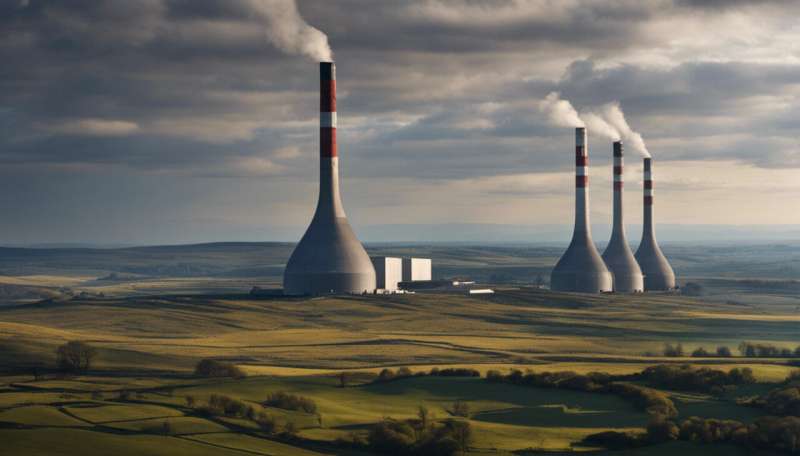Credit: AI-generated image (disclaimer)
The high global gas price has quadrupled the wholesale energy price for consumers across the UK over the last six months, with those on default tariffs paying by direct debit likely to see their average annual bill rise by £693, from £1,277 to £1,971.
To begin insulating the public from volatile gas prices, the government plans to accelerate the pace at which it is deploying renewable energy and low-carbon technologies. That means an increase in the nation's offshore wind capacity from 11 gigawatts (GW) today to 50GW by 2050—10GW more than its previous target—and eight new nuclear power stations.
Yet apart from a promised five-fold increase in solar power generation by 2035, the strategy sets no target for generating electricity from some of the country's cheapest sources, like onshore wind.
The government may defend its decision to ramp up the production of nuclear power as support for a home-grown and reliable source of energy. But some of that hefty investment would be unnecessary if Britain reorganised its energy system to make the most of the nation's abundant renewable electricity instead.
When the price of a commodity like a soft drink goes up, production can be ramped up fairly rapidly to respond to spot market conditions, which quickly lowers prices again. Building a new nuclear power plant or offshore wind farm is quite different, requiring major investment and the certainty that there will be a reasonable return on upfront investment from selling energy over 30 to 40 years.
In the UK, governments can intervene in the capacity market to ensure a secure electricity supply by paying for reliable sources, which provides the long-term certainty necessary to build sufficient generating capacity. Financial backing changes to reflect the state's priorities, and the drive for eight new nuclear reactors is reported to cost the public £13 billion.
Building wind farms and nuclear plants is just the first step though. The speed at which they be can integrated into electrical networks and operated to be in tune with power, transport and heat demand is what will actually decide when energy prices stabilise.
Wind and solar energy sources cannot change their output to match the minute-by-minute needs of customers. System operators must either instruct renewable generators to dump some of their energy when demand is low but wind and sunshine is high, or ask fossil power plants to fire up and fill the gap when demand is too much for becalmed wind turbines to meet.
The cost of the former is around £20 million a day. The annual cost of balancing the energy system in this way reached a record £1.2 billion in 2021, up from 5% of the wholesale energy cost in 2010 to 20% today.
How to get inflexible, low-carbon energy to homes and businesses reliably and cheaply is as important as building new, reliable sources. And on that count, making more effective use of renewable sources—and reducing energy demand overall—would mean the country could afford to build less nuclear power, which is one of the few low-carbon sources which hasn't become substantially cheaper.
New technologies
One way to increase customer demand for renewable and low-carbon energy when it's abundant and reduce it when generation is tight is to incentivise storage technologies.
For example, if electric vehicles are charged up when there is plenty of wind and solar power being generated, 40GW of offshore renewable energy would be enough to power the country's entire vehicle fleet without any of it going to waste.
To help harmonise Britain's energy demand with periods when renewable output is high, the government could invest in digital technologies such as smart meters and set up new tariffs which can send price signals to EV chargers. It could also invest in improving the short-term forecasting of solar and wind output. These changes would make distributors aware of customer needs and help customers alleviate stress on the system.
While electric vehicle batteries can manage the variability of renewable output, Britain's energy system also needs fixed storage—like grid-scale batteries which, unlike the government's favoured solution of hydrogen fuel, are capable of very fast response times to manage sudden changes.
Enabling millions of electric vehicles and heat pumps to tap into nuclear energy and renewable power generated in the remote North Sea is no small undertaking—it requires urgent changes in how the UK's energy system operates.
For instance, using passenger electric vehicles to help manage renewable output will require access to personal data, such as the location of a vehicle when it is plugged in, or real-time energy use in a customer's home. Rules need establishing to assure customers that this data will be protected rather than abused and used for anything other than system management.
But the energy strategy offers little in navigating the complexity of integrating EVs in garages with wind farms offshore. The result could be a fragmented system—unreliable and costly to maintain as decarbonisation intensifies.
Provided by The Conversation
This article is republished from The Conversation under a Creative Commons license. Read the original article.![]()
























